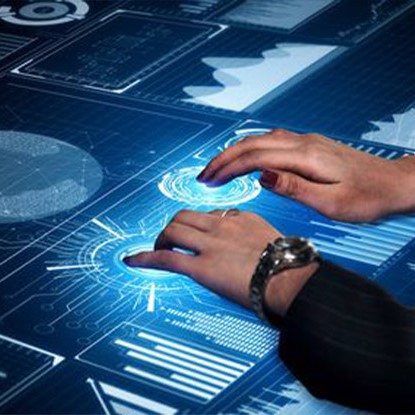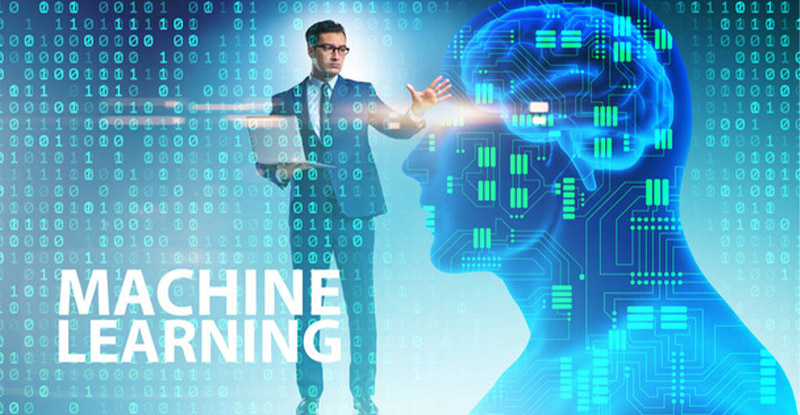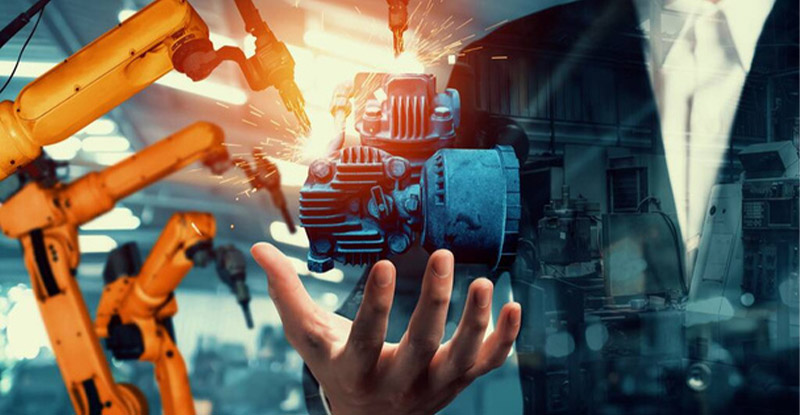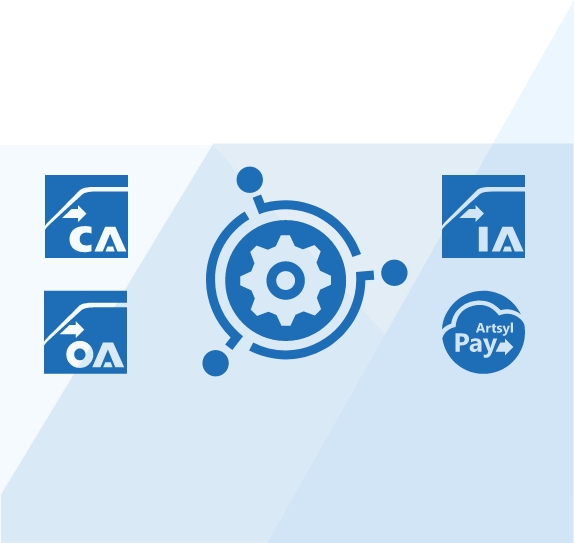Machine learning applications: Which ones make the most business sense? Machine learning is a rapidly growing field in the world of technology. It involves the use of algorithms to identify patterns in data, enabling computers to learn and improve without human instructions.
Today, machine learning applications are being leveraged by businesses across various industries in different ways to achieve better results. In this article, we will discuss some of the most popular machine learning applications that businesses are using to drive success.

Unlock the power of intelligent data capture with Artsyl docAlpha:
Are you tired of manual data entry errors slowing down your business processes? Experience the future with Artsyl docAlpha’s machine learning-driven data capture. Schedule your personalized demo and watch your productivity soar!
Machine Learning Applications: What Are They?
Machine learning is a subfield of artificial intelligence that uses statistical techniques to give computer systems the ability to learn from data, without being explicitly programmed. This means that instead of manually writing code to tell a computer what to do, we feed data to a machine learning algorithm, and it automatically learns to identify patterns and make decisions based on that data.
Machine learning is being used in a wide range of applications across different industries. Let’s take a look at the most common types of machine learning applications.
Natural Language Processing (NLP)
NLP is the ability of a computer system to understand human language and generate responses in natural language. Some common applications of NLP include virtual agents, chatbots, sentiment analysis, and language translation.
Computer Vision
Computer vision is the ability of a computer system to interpret and understand visual information from the world around us. Some common applications of computer vision include image and video recognition, facial recognition, object detection, and gesture recognition.
Fraud Detection
Fraud detection is the use of machine learning algorithms to identify and prevent fraudulent activities. This includes credit card fraud detection, insurance fraud detection, and identity theft detection.
Predictive Analytics
Predictive analytics is the use of machine learning algorithms to analyze data and make predictions about future events. This includes forecasting, customer behavior analysis, and risk management.
Recommendation Systems
Recommendation systems are used to suggest products or content to users based on their past behavior or preferences. This includes recommendation systems used by e-commerce sites, streaming services, and social media platforms.
Now that we have met the most common technologies used in machine learning applications, let’s meet some of them more closely.
Imagine a world where your Accounts Payable process learns from every invoice and payment, optimizing itself for speed and accuracy. With Artsyl docAlpha, that world is a click away. Unleash machine learning capabilities that revolutionize your AP operations. Don’t settle for less; transform with the best.
Book a demo now
Machine Learning Applications in Various Industries
Machine learning (ML) has evolved dramatically over the past few years and is significantly transforming a broad range of industries by automating processes, providing valuable insights, and solving complex problems. Below is a detailed discussion on how machine learning applications have made a positive impact across various sectors.
Machine Learning Applications for Healthcare
Machine learning algorithms are increasingly being used for diagnostics, treatment recommendations, and drug discovery. For example, machine learning models can analyze medical images to detect abnormalities such as tumors, or predict patient outcomes based on historical data. Google Health’s DeepMind has made strides in applying ML to medical research, especially in the area of disease identification and risk stratification.
Machine Learning Applications for Finance
Financial institutions use machine learning for fraud detection, risk management, customer service, and algorithmic trading. ML algorithms can identify patterns in financial transactions that are indicative of fraudulent activity. Companies like Kabbage and Adyen use machine learning to assess the credit risk of loans and process large volumes of payments, respectively.
Machine Learning Applications for Retail
In retail, machine learning powers recommendation systems that provide personalized shopping experiences. Algorithms analyze customer behavior, purchase history, and other variables to suggest products, thereby increasing sales and customer engagement. Amazon is a prime example of using machine learning for product recommendations.
Machine Learning Applications for Manufacturing
Machine learning models are applied in quality control and predictive maintenance in manufacturing processes. These algorithms analyze data from machines to predict failures before they occur, thereby minimizing downtime. General Electric uses machine learning to analyze data from its aircraft engines and wind turbines to predict when they might fail.
Machine Learning Applications for Automotive
The automotive industry uses machine learning in the development of autonomous vehicles. Algorithms process data from sensors in real-time to make driving decisions. Companies like Tesla and Waymo are spearheading the use of machine learning in self-driving technology.
Machine Learning Applications for Energy
ML algorithms can predict energy demand and optimize supply accordingly. They are also used in the maintenance of power grids and equipment. For instance, DeepMind has partnered with Google to reduce the energy used in cooling their data centers by up to 40% using machine learning algorithms.
Machine Learning Applications for Agriculture
Farmers are using machine learning to analyze data related to weather, soil, and crops to make better decisions. ML can predict crop yields, recommend planting times, and even identify potential diseases or pests.
Machine Learning Applications for Media and Entertainment
Machine learning algorithms are used for content recommendation, personalization, and customer retention in the media industry. Companies like Netflix and Spotify use machine learning to recommend movies or songs based on users’ previous behavior.
Machine Learning Applications for Real Estate
Machine learning models can predict property prices with high accuracy by analyzing various factors like location, size, and market trends. Companies like Zillow use machine learning to give ‘Zestimates’ of property values.
In summary, machine learning is radically changing the landscape of multiple industries by automating complex tasks, providing actionable insights, and enhancing user experiences. As ML technology continues to evolve, its applications will become even more diverse, offering even greater efficiencies and solutions.
Intelligent Process Automation Solution
Related Videos
Machine Learning Applications in AP Automation
Machine Learning (ML) has become increasingly pivotal in enhancing Accounts Payable (AP) automation solutions. The capabilities of machine learning algorithms extend far beyond basic data sorting and transaction matching.
Related: Machine Learning AP Solutions: A Guide to the Future of Accounting
Below are some key applications of machine learning in AP Automation:
- Invoice Recognition: Machine learning can be used to recognize and extract important information from invoices, such as vendor details, invoice numbers, and amounts, even when the format varies from vendor to vendor.
- Intelligent Workflows: Based on historical data, machine learning can predict which invoices are likely to be approved or require additional scrutiny, and automatically route them accordingly.
- Dynamic Approval Chains: ML can adapt approval chains in real-time based on various criteria like amount, vendor, or project code.
- Document Classification: ML algorithms can automatically classify different types of financial documents, directing them through the appropriate workflow channels.
- Anomaly Detection: Machine learning algorithms can flag irregular transactions that deviate from historical patterns, assisting in the prevention of fraud.
- Risk Assessment: ML models can rate vendors based on risk factors, helping companies manage their relationships more effectively.
- Dynamic Discounting: Machine learning can identify opportunities for early payment discounts based on past payment behavior and current cash flow.
- Cash Flow Forecasting: ML algorithms can analyze past payment cycles, current liabilities, and receivables to forecast cash flow, aiding in better financial decision-making.
- Compliance Monitoring: Machine learning can automatically check invoices and payments against compliance rules and flag any potential issues for review.
- Automated Reporting: ML can assist in generating real-time reports and dashboards, offering valuable insights into AP performance metrics.
One of the most impactful aspects of ML is its ability to learn from every transaction, continually updating its models to improve accuracy and efficiency. To further expand AP automation, machine learning can adapt to the specific needs and behaviors of AP professionals, customizing the interface and suggestions for individual users.
By harnessing the capabilities of machine learning, AP Automation software can significantly improve efficiency, reduce errors, and add a layer of intelligence to the AP process, thereby saving both time and money for the organization.
Related: Machine Learning AR Solutions
Fraud is a pressing concern for many businesses, but Artsyl docAlpha’s machine learning algorithms are your first line of defense. Our platform analyzes transaction patterns in real-time to flag any irregularities, ensuring your financial security. Can you afford not to be protected?
Book a demo now
Customer Service Machine Learning Applications: Chatbots
Machine learning applications in the realm of customer service, particularly with chatbots, have taken significant strides in recent years. These intelligent chatbots are designed to mimic human interactions, provide instant support, and resolve queries in a more personalized and efficient manner. Below are some key machine learning applications for chatbots in customer service:
Thanks to Natural Language Understanding (NLU), machine learning helps chatbots understand the user’s intent, even if the language used is ambiguous or imprecise. ML algorithms can assess the sentiment behind user interactions, helping the bot decide how to respond.
Machine learning models can guide users through a troubleshooting process, helping to solve problems without human intervention. Based on the query complexity and category, chatbots can route the issue to the appropriate human agent. To make conversations more personal, ML algorithms can analyze past interactions to create a profile of the user’s preferences and behavior. Based on the conversation flow, chatbots can suggest quick replies that users can choose from, speeding up the interaction.
In addition, ML-powered chatbots can predict what the user is trying to type and offer suggestions, making interactions quicker. Machine learning can analyze chat transcripts to identify areas of improvement, common queries, or issues.
Machine learning enables chatbots to learn from each interaction, improving their efficiency and effectiveness over time. With ongoing advances in ML technology, customer service chatbots are becoming more sophisticated and are able to handle a wider array of tasks, thus improving customer satisfaction and reducing operational costs.
Financial Services: Fraud Detection
Fraud is one of the major security threats modern businesses face. Fraud detection has been revolutionized by the advent of machine learning, providing an extra layer of security that traditional methods can’t offer.
Machine learning algorithms allow companies to detect and prevent fraud using real-time data analysis and anomaly detection. The algorithms used for fraud detection are trained on past data to identify patterns that can help detect and prevent fraudulent activities.
Machine learning algorithms can also analyze vast amounts of transactional data in real-time to identify unusual patterns or anomalies that may signify fraudulent activity. These algorithms are capable of learning from each transaction, continuously improving their detection capabilities.
As a result, businesses can proactively flag and investigate suspicious transactions, reducing the risk of financial loss and enhancing overall security. The dynamic and self-improving nature of machine learning makes it an invaluable tool in modern fraud detection systems.
Construction: Predictive Maintenance
Machine learning algorithms are also used to predict equipment failures before they occur. This method is called predictive maintenance and involves analyzing sensor data to detect any anomalies.
Predictive maintenance powered by machine learning is transforming the way industries approach equipment upkeep. By analyzing historical data along with real-time metrics from sensors, machine learning algorithms can predict when a machine is likely to fail or require maintenance, far in advance of actual breakdowns.
This predictive capability allows companies to perform targeted maintenance activities only when needed, thereby minimizing downtime and extending equipment lifespan. Compared to traditional reactive or scheduled maintenance approaches, machine learning-based predictive maintenance is more cost-effective, efficient, and can significantly improve operational reliability. As a result, predictive maintenance helps businesses reduce downtime, repair costs, and improve overall machine efficiency.
Services: Predictive Analytics
Predictive analytics is a machine learning application that helps businesses make data-driven decisions, increasing efficiency, and optimizing resources. Predictive analytics involves forecasting events using historical data and identifying patterns that can help optimize future decisions.
With predictive analytics, businesses can make better decisions on pricing, inventory management, and supply chain management.
Keep your business running smoothly with predictive maintenance features built into Artsyl docAlpha. Our machine learning algorithms monitor your systems, predicting when maintenance is due before a breakdown occurs. Don’t wait for a system failure to bring your business to a halt. Get started with Artsyl docAlpha and preempt operational setbacks.
Book a demo now
Use Cases: Machine Learning Applications in Different Industries
Machine learning (ML) is rapidly transforming a variety of industries by enabling intelligent data analysis, decision-making, and automation. Below are some use cases of machine learning applications across different sectors.
Healthcare
- Disease Prediction and Prevention: Machine learning algorithms analyze patient records to predict disease risks and recommend preventative measures.
- Drug Discovery: ML models can analyze biological data to speed up the drug discovery process, potentially reducing time and costs.
Finance
- Fraud Detection: Machine learning algorithms can analyze transaction patterns and flag fraudulent activities in real-time.
- Algorithmic Trading: ML models can predict stock market trends and execute trades at optimal times.
Retail
- Recommendation Systems: Machine learning algorithms analyze customer behavior and preferences to recommend products.
- Inventory Management: ML can predict stock requirements based on various factors, thus optimizing inventory levels.
Energy
- Smart Grid Management: Machine learning algorithms can forecast energy demand and optimize the distribution of energy across smart grids.
- Predictive Maintenance: Predict when machines in power plants need maintenance to minimize downtime.
Automotive
- Self-Driving Cars: Machine learning algorithms are key in enabling autonomous vehicles to interpret sensor data and make driving decisions.
- Predictive Maintenance: ML can forecast when parts of a vehicle are likely to fail, thus recommending proactive maintenance.
Manufacturing
- Quality Control: Machine learning can automate the process of quality control by identifying defective products on the assembly line.
- Supply Chain Optimization: ML algorithms can predict disruptions and bottlenecks in the supply chain.
Agriculture
- Yield Prediction: Machine learning models can predict crop yields based on soil quality and weather conditions.
- Pest Prediction: ML can analyze environmental data to predict pest attacks, helping in timely prevention.
Entertainment
- Content Recommendation: Services like Netflix and Spotify use machine learning to recommend shows, movies, and music based on user behavior.
- Audience Analysis: ML can analyze audience reactions to tailor marketing or modify content.
Public Safety
- Crime Prediction: Machine learning algorithms can analyze crime data to predict where and when crimes are likely to occur.
- Disaster Response: ML can help in predicting natural disasters and optimizing response plans.
Human Resources
- Resume Screening: ML algorithms can automatically sort through resumes, making the recruitment process more efficient.
- Employee Retention: ML can predict which employees are most likely to leave the company, allowing for proactive retention efforts.
This is just the tip of the iceberg. The potential applications of machine learning are vast and continue to grow as the technology matures.
Struggling with keeping track of various vendors and their reliability? Artsyl docAlpha’s machine learning algorithms not only help you sort through invoices and payments but also build a predictive vendor profile for your business. Know who to trust and when to order with Artsyl’s intelligent vendor management.
Book a demo now
Final Words: The Future Looks Bright for Machine Learning Applications
Machine learning has proven to be a game-changer in the world of technology. Whether it’s improving the customer experience, preventing security threats, or optimizing business operations, machine learning is playing a crucial role in driving business success. From chatbots and fraud detection to predictive maintenance and analytics, the applications of machine learning are wide and varied.
As more businesses continue to adopt machine learning technology, we can expect to see more innovation, greater efficiency, and a more personalized customer experience.
Key Terms Explained
What is machine learning?
Machine learning is a subset of artificial intelligence (AI) that focuses on developing algorithms and statistical models that enable computer systems to improve their performance on a specific task over time, without explicit programming. It involves the use of data to train models, allowing computers to learn patterns, make predictions, and adapt to changing circumstances. Machine learning is applied in various fields, such as image recognition, natural language processing, recommendation systems, and predictive analytics.
How does machine learning work?
Machine learning works through the following key steps:
- Data Collection: Gather relevant and representative data related to the task at hand. This data serves as the foundation for training and evaluating machine learning models.
- Data Preprocessing: Clean, organize, and preprocess the collected data to remove errors, handle missing values, and ensure it is suitable for training.
- Feature Extraction: Identify and select the relevant features (variables) from the data that will be used to train the machine learning model.
- Model Selection: Choose an appropriate machine learning algorithm or model based on the nature of the task (e.g., classification, regression, clustering).
- Training the Model: Feed the algorithm with the prepared data to train the model. During training, the model learns patterns and relationships within the data.
- Evaluation: Assess the model’s performance using a separate set of data not used during training. This step helps ensure the model can generalize well to new, unseen data.
- Fine-Tuning: Adjust the model’s parameters or features to improve its performance based on the evaluation results.
- Prediction: Once trained and fine-tuned, the model is ready to make predictions or decisions when presented with new, unseen data.
- Deployment: Integrate the trained model into applications or systems where it can be used to automate tasks, make predictions, or assist in decision-making.
- Monitoring and Maintenance: Regularly monitor the model’s performance in real-world scenarios, and update or retrain it as needed to adapt to changes in the data distribution.
Machine learning is a dynamic field, and various algorithms and techniques are applied depending on the specific problem and goals of the application.
What is the difference between machine learning and artificial intelligence?
Machine learning (ML) and artificial intelligence (AI) are related concepts but have distinct meanings. Machine learning is a subset of AI, focusing on algorithms that enable computers to learn from data and make predictions or decisions. AI, in a broader sense, encompasses various approaches to creating intelligent systems capable of tasks like problem-solving, reasoning, and understanding.
While machine learning specifically deals with learning from data, AI includes a wider range of techniques and goals in developing intelligent agents. In essence, machine learning is a tool within the broader landscape of artificial intelligence.
What is machine learning used for?
Machine learning is used across various industries and applications for a wide range of tasks. Some common uses of machine learning include:
- Image and Speech Recognition: Machine learning enables systems to recognize and interpret images and speech, leading to applications like facial recognition, object detection, and voice assistants.
- Natural Language Processing (NLP): NLP techniques, a subset of machine learning, are used for language-related tasks such as sentiment analysis, language translation, and chatbots.
- Predictive Analytics: Machine learning models can analyze historical data to make predictions about future trends, behaviors, or outcomes. This is widely used in finance, marketing, and healthcare.
- Recommendation Systems: Platforms use machine learning algorithms to analyze user preferences and recommend products, services, or content tailored to individual users’ tastes.
- Healthcare Diagnosis: Machine learning aids in medical diagnosis by analyzing patient data to identify patterns and predict diseases. It’s used in areas like radiology, pathology, and personalized medicine.
- Financial Fraud Detection: Machine learning algorithms can identify patterns indicative of fraudulent activities in financial transactions, helping detect and prevent fraud.
- Autonomous Vehicles: Machine learning is crucial for self-driving cars, enabling them to perceive their environment, make decisions, and navigate safely.
- Manufacturing and Predictive Maintenance: ML helps optimize manufacturing processes, detect anomalies, and predict equipment failures, reducing downtime and maintenance costs.
- Customer Churn Prediction: Businesses use machine learning to predict which customers are likely to churn, allowing them to implement retention strategies.
- Robotics: Machine learning contributes to the development of intelligent robots capable of adapting to changing environments and performing complex tasks.
These are just a few examples, and the applications of machine learning continue to grow as the field evolves. Its ability to analyze large datasets, recognize patterns, and make predictions has led to transformative advancements in various domains.



 Machine Learning Models: Navigating Their Power and Applications
Machine Learning Models: Navigating Their Power and Applications Machine Learning vs Artificial Intelligence: An Overview
Machine Learning vs Artificial Intelligence: An Overview Artificial Intelligence vs Machine Learning: A Comparison
Artificial Intelligence vs Machine Learning: A Comparison Statistics in Machine Learning: What Is Its Role?
Statistics in Machine Learning: What Is Its Role? A Comprehensive Guide to Accuracy in Machine Learning
A Comprehensive Guide to Accuracy in Machine Learning The Rise of Machine Learning in Business
The Rise of Machine Learning in Business

